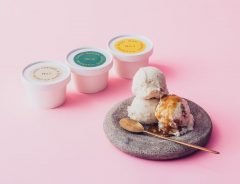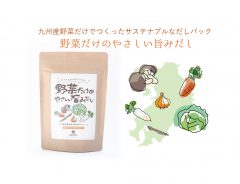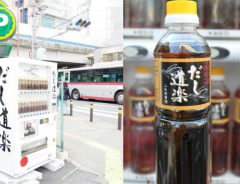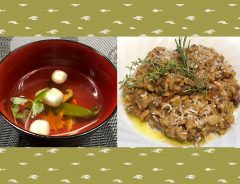- Tags:
- comfort food / Dashi / home cooking / Oden / Ranking / winter food
Related Article
-

Its flowers smell like rotting flesh and Japanese people eat this plant’s roots all year round
-

Girls envy confectioners and boys idolize police: top jobs in the minds of Japanese kids
-

Fishy ice cream? Katsuobushi company Ninben subtly blends bonito into ice cream trio
-

You can help reduce food loss when you buy this vegetable dashi made with imperfect produce
-

You Can Now Grab Quality Dashi On The Go From Vending Machines In Tokyo
-

From suimono to risotto, this microwaveable dashi pot worked wonders in our kitchen



What is Oden?
A familiar sight at Japanese convenience stores, and a popular menu item in izakaya gastropubs, oden (おでん or 御田), a kind of stewed dish, is one of Japan's favorite winter comfort foods. Many ingredients feature in oden but what they all have in common is that they are served in a light and flavorful broth, traditionally containing dashi and soy sauce. Typical favorites are daikon radish, various fishcakes, konjac, tofu, sausages, boiled eggs, and skewered meats. Both in terms of broth and ingredients, there are many regional variants of oden you can enjoy.
Where can you get your oden fix?
Many people get hooked on oden once they try it. But since oden is usually served in an open pot, it has temporarily disappeared from many convenience stores during the pandemic. The service may return when the pandemic subsides. But in the meantime, your best bet is to visit a specialty oden restaurant, buy premade oden packs from a store, or buy the individual ingredients to make your own combinations. If you're really feeling adventurous and you have the time, you could even try making some of the elements from scratch!
Making oden at home
Our oden-loving writer decided to combine a premade oden pack with individual ingredients bought at a supermarket to make a pot of oden.
The main star was an 18-piece set of 16 different ingredients called Uogashi Oden 魚河岸おでん made by Mizuno Suisan Co., Ltd. 水野水産, based in Miyagi Prefecture, which he picked up at the Seijo Ishii 成城石井 supermarket.
The pack features various kinds of nerimono 練り物 which refers to surimi fishcakes of all varieties. Some examples you'll find in oden are chikuwa 竹輪 tubed fish cakes, gobō-maki ごぼう巻き fishcake with burdock root, date-maki 伊達巻 egg and fish cake and satsumaage さつま揚げ fish cake blended with vegetables. This pack also featured other kinds with shrimp and crab, as well as tsumire つみれ balls made with ground sardine.
Photo by grape Japan
In addition, he bought hanpen はんぺん, a white fluffy fishcake made from grated Japanese mountain yam, surimi and seaweed stock, konnyaku (konjac cake), ito-konnyaku (konjac cake cut into strips), strips of kombu seaweed tied into a decorative knot, as well as a daikon radish, some eggs and pork sausages.
Photo by grape Japan
Oden broth
Although the pack of oden came with its own broth which our writer also tried on a separate occasion, he also wanted to try making his own oden broth since he happened to have a very convenient microwaveable dashi pot at his disposal.
Photo by grape Japan
Using some good quality kombu from Rausu, Hokkaido and shaved honkarebushi bonito from Kagoshima, it was just a matter of adding 800 cc of water and putting it uncovered in the microwave for 7 minutes at 500 W and he had some delicious dashi ready to use.
Photo by grape Japan
Photo by grape Japan
With the dashi in a small saucepan, it was time to season it to make oden broth...
Photo by grape Japan
To this, he added a tablespoon of sake, two tablespoons of mirin, two tablespoons of light (usukuchi) soy sauce, and half a teaspoon of salt.
Photo by grape Japan
Cooking time
He cut the hanpen and konjac into triangles, prepared the eggs (cooked, shelled, then simmered in water, soy sauce and mirin) then put the other ingredients in a big pot with the oden broth.
Photo by grape Japan
It's important to be sure the broth doesn't boil over and keep it at a low to medium simmer for about 15 minutes.
Photo by grape Japan
Then, pick out the ingredients with a pair of long cooking chopsticks, pour over some of the broth and serve!
Photo by grape Japan
For additional flavoring, you can use Japanese karashi mustard, yuzukoshō 柚子胡椒, a condiment made with yuzu citron and pepper, or misodare a sweet and savory miso sauce...
Favorite five oden ingredients
After he had cooked all that delicious oden and enjoyed it with his family, he decided to rank his favorites.
1. Nerimono: shellfish
Photo by grape Japan
In his pack of Uogashi Oden from Mizuno Suisan, there were many tasty ingredients but in particular, there were two types of ingredients featuring crab or shrimp, and our writer found these to be the tastiest of all the selections in the entire oden pot. These seafood balls were packed with seafood flavor and they were just the right texture, not too soft and not too hard.
2. Sausage
Photo by grape Japan
Maybe our writer was biased because he loves hot dogs and frankfurters, but the familiar flavor of the sausage and the flavorful umami-rich oden broth blended perfectly, making this simple ingredient one of his favorites. He was also fortunate to have used tasty Vienna sausages made with Japanese pork from Frieden.
3. Daikon
Photo by grape Japan
If you've only had daikon in salads or in miso soup, you're in for a surprise when you try it in oden. Our writer had tried daikon in convenience store oden and was already a fan, and this time was no different. The daikon soaks up the delicious oden broth and almost melts in your mouth. If there was anything he would do differently next time, it would be to cut the daikon more thickly.
4. Chikuwa
Photo by grape Japan
Chikuwa is one of the most well-known nerimono made of surimi and shaped into a long cylinder with a hollow center. The name chikuwa 竹輪, meaning "bamboo ring," comes from its shape when you slice it. There's just something about its appearance that is fun, says our writer. Mizuno Suisan's chikuwa even has their company name 水野 printed on it, and it's also the tastiest chikuwa he's ever had.
5. Hanpen
Photo by grape Japan
Made from grated Japanese mountain yam, surimi and seaweed stock, hanpen has a wonderfully fluffy and soft, marshmallowy texture and a mild seafood taste. It soaks up the oden broth and melts in your mouth. Our writer used Kaheiya's 嘉平屋 Atsuban Hanpen 厚判はんぺん which was particularly flavorful. Highly recommended.
Other ingredients
These other ingredients weren't part of the ranking but we'd like to introduce them since they're also well-known oden ingredients you can try.
Satsuma-age
Golden brown on the outside, white on the inside, Satsuma-age can only have surimi or it can also be blended with vegetables like carrot, edamame and lotus root.
Photo by grape Japan
Egg
You can flavor it in advance, as explained above, or if that's too much of a hassle, just use a cooked egg. There are also pre-flavored eggs you can buy in convenience stores and supermarkets.
Photo by grape Japan
Konnyaku
Konnyaku (konjac) is often enjoyed for its texture rather than its flavor, but good quality konnyaku also has a distinctive but subtle flavor. The dark color of this one comes from hijiki and it also contains grated yam. Cut it into triangles for your oden.
Photo by grape Japan
Ito-Konnyaku
This is usually made with konnyaku that isn't darkened with hijiki, so it's lighter in color. The complex texture which comes from the strips tied together with a bundle in the middle makes it a fun ingredient to eat, and it picks up a lot of the flavor from the broth.
Photo by grape Japan
Kombu
Oden kombu is usually tied in a knot, but you can of course use regular kombu in small strips. If you bought kombu to make dashi, it can do double duty in your oden pot. We recommend getting some good quality kombu for that purpose.
Photo by grape Japan